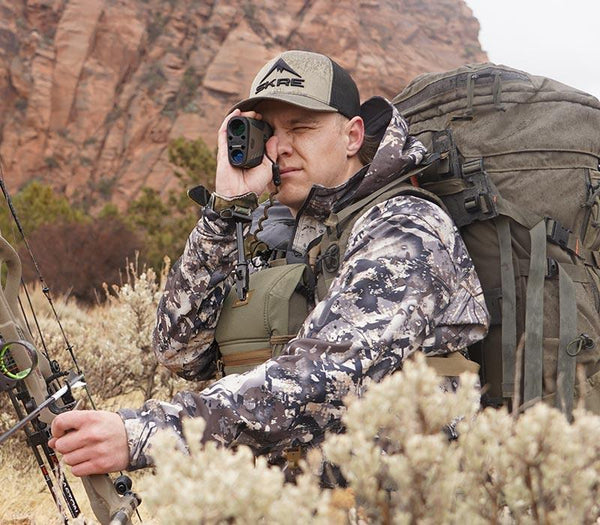Hunting in the 21st Century
Apr 29, 2021
- Do these advance wildlife conservation and fair chase or do they hurt the hunting community and the wildlife we love?
- Where do we draw the line?
- What should and should not be allowed to assist hunters in pursuit of their quarry?
Looking To Save?
The SKRE Gear® Elite Starter Bundle is perfect for those looking to get started with their layering system. Save 20% for a limited time!
Shop NowOptics
Binoculars
Optics in the 80’s pale in comparison to todays optics. I remember deer hunting in the west with my grandfather in the late 70’s and early 80’s. He had an ole pair of Bushnell binoculars and I remember him letting me use them to glass for deer. They were fuzzy at best, and really did not offer much of an advantage. They should have sold a bottle of Aspirin with every pair to help with the headache that you were certain to get after using them. Frankly, most hunters used their rifle scopes to examine distant objects. This is obviously not the safest practice, since often times those objects ended up being other hunters. The advancements in glass coatings for optics allow for a much sharper and crisper images. The difference in clarity is especially apparent in low light hours. And as many hunters know, this is when animals are most active. The advancements also allow hunters to see farther and glass longer. Having the ability to spot an animal 1-2 miles away allows hunters to be more efficient with their time. After spotting the animal, you can use a spotting scope to examine the animal in more detail. This will help you decide if you want to pursue that specific animal and help avoid a lot of unnecessary hikes. While optics allow hunters to be more efficient at spotting animals, that efficiency does not always translate to success. You still must close the distance, relocate the animal, and make the shot. I do not believe quality optics take the hunt out of hunting. I believe quality glass makes the experience of hunting more enjoyable.
Scopes
Advancements in rifle scopes on the other hand give hunters a massive advantage when it comes to shot placement. Turrets in yardage, MOA and Mil allow hunters to dial in and shoot with precision accuracy. The long-range debate is one that may never be settled. I recall a November mule deer hunt with my son a few years back. There was a fresh 10 inches of snow on the ground when we awoke the next morning. We hurried to one of our favorite areas and quickly spotted a big buck. He was bedded in some sparse Aspens and there was a clear shot to his vitals. However, he was 600 yds away and I elected to get my son closer, despite knowing we had a rifle and an experienced shooter who could make that shot. We moved in closer, but the buck had gotten up and was making his way into some thicker cover. My son really felt like he still had a shot, so I told him to take it. At the shot, the buck jumped. When we went to inspect the area, there was some good blood. We tracked him for over a mile, but eventually the blood stopped. It became more apparent that the buck was moving out nicely. We determined that the bullet hit an unseen branch, which soaked up the bulk of the energy before hitting the deer. The lesson I learned from the hunt with my son is to take the shot that has the highest probability of a clean kill. Does having a weapon topped with superior optics give hunters an unfair advantage over the animals we hunt? Or does it make us more efficient at cleanly and humanely harvesting animals? I think the answer to both questions is a resounding yes.
Range Finders
Rangefinders have been one of the largest advancements in the hunting industry in the last 30 years. It has all but taken the guess work out of determining the range of an animal. This is great for the hunter, but maybe not so great for the animals we hunt. Pair that range finder with a turreted rifle scope previously discussed and you have a deadly combination. Place those tools into the hands of a capable shooter and there is going to be a lot of tags filled and meat in the pot. One could argue that a shot is unethical when you are shooting at an animal at an undetermined distance. This would mean that range finders are helping create more ethical hunters. Game managers and biologist allocate tags and manage populations based on harvest percentages that are well below the 100% mark. Even with rangefinders and other technological advancements, the average success rates are nowhere near 100%. There are factors such as habitat loss, predation, and poor heard management that play a factor in the decline we have seen with tag numbers in the West. But there is no denying that the decline isn't influenced by hunting technology advancements as well. Taking our advancement with optics, scopes, and range finders into consideration, we need to ask ourselves...do we want the range we can harvest an animal legislated by government? Even if a bill were passed into law dictating the distance, how could it be effectively regulated, monitored, and enforced?
Night Vision
I was recently at a friends house just after sundown when he told me he had something he want to show me. He proceeded to fetch his newest investment in night vision, thermal optics. He had just purchased a night vision rifle scope for one of his rifles and a new pair of night vision binos. We stepped out the back door into the darkness to have a look at his livestock in the distance. The rifle scope and binos were essentially the same technology. Both provided night vision and thermal imaging. I was stunned as I put the binos to my eyes. The veil of darkness became like day and you could see his horses and other farm critters like it was day light. While this type of hunting technology is illegal in many states, some states allow its use to manage predators and feral hogs. There is also some newer hunting technology that allows users to pinpoint the location of almost any animal on a hill side during daylight hours.
Looking To Save?
The SKRE Gear® Elite Starter Bundle is perfect for those looking to get started with their layering system. Save 20% for a limited time!
Shop NowBallistic Apps
In recent years, there has been an invention of ballistic apps that has greatly added to hunting technology. These apps can be downloaded and then utilized while in the field. These apps account for things like muzzle velocity, rate of twist, scope height, BC, wind, Coriolis, spin drift, angle, barometric pressure, altitude, and more. Some of these can even Bluetooth to a Kestrel device which calculates almost everything real time. This would then give you an almost immediate shooting solution. Regardless of where you stand on this issue, it has never been more enjoyable (or accurate) to be a shooter than in the 21st century. The debate has and always will be one of ethics. There is a very sizable crowd that believes that just because you can shoot at 1000 yards doesn’t mean you should. Still, long range hunting is growing at a startling pace. It seems that both sides are locked into an eternal battle of ethics vs efficiency.
Trail Cameras
There is no hotter topic of discussion than the use of trail cameras, especially in the Western states. States like Nevada have already created laws that regulate the use of trail cameras during hunting seasons. I asked one of the larger, successful outfitters in Nevada how these new law has affected them. He said it has had zero affect on their success rates and has not really changed the way they hunt. The advantage of having a picture of an animal with a time and date stamp on it can help a hunter decide where to hunt. But this in no way guarantees you will be successful in locating that animal, let alone harvesting it. While it these laws are not yet widely spread, many states such as Arizona and Utah seem to be close behind. The ultimate question regarding trail cameras is if they assist in the unethical harvesting of animals. What do we hope to accomplish if sportsmen were to agree on regulating or banning trail cameras? Is it to reduce harvest, promote fair chase, purely ethics, or something else?
Communication Devices
That fact that most adults who own smart phones have a mountain of information in a device that is smaller than a deck of cards is nothing short of a modern-day miracle. Owners of these devices can communicate with others via voice, email, text, FaceTime, social media, and other communication apps. The earth is dotted with communication towers allowing people to communicate with others even in remote locations. These advancements in communication have proven to benefit hunters safety by allowing them to check in with loved ones at home. However, it also allows them to communicate with hunting companions while in the field. Even in areas with spotty cellphone service, many hunters also take advantage of two-way radios. And even in the most remote places, such as the Arctic, there are devices like spot messenger that allow hunters to communicate. These communication devices can and are used to guide hunters into game. States like Colorado have made it illegal to use two-way radios in the taking of big game. Boone & Crockett adopted the following rule regarding communication devices:
"The Club believes that having another person on the other end of a two-way radio or cell phone to help locate or guide a hunter to game is not fair chase.”
Does Boone and Crockett represent all hunters? Certainly not all, but their claim that using communication devices to take an animal is not fair chase has been debated for years.
ATV’s
In 1970, Honda released the first production model 3-wheeler which was a hit with all outdoor enthusiasts. Hunters begin using these to access some of the more remote roads and trails not previously accessed by motorized vehicles. They were cool as hell, and if you drove one you were cool as hell. But they were also dangerous as hell, with you being able to roll one on top of you quite easily. Consequently, their popularity only lasted a decade or so before Suzuki released the first four-wheeler in 1982. It was a much more stable option, and it didn’t take long before the 4-wheeler became the new norm. Then, in 1986, Honda unveiled the first four-wheel-drive ATV, the FourTrax 350 4x4. For its grand unveiling it was lowered from a helicopter to show all four wheels moving under their own power. This gave these machines access to even more rugged and remote terrain. I purchased my first ATV back in 2000 and was floored at the places I could access, and the terrain it could tackle with ease. Plain and simple, it allowed me access areas I had not previously explored. The rest is history.UTV's
Fast forward to the present day 21st century and with the continued advancements in technology, we now have side by sides, also known as UTV’s. These can cost as much as a truck and come equipped with most the features of a regular automobile including space to fit all your hunting buddies and their gear. Like them or not, these miniature motorized tanks completely changed the way we hunt. It has encouraged many hunters to never leave the road and has allowed hunters to cover more country faster. The innovations in ATV’s have substantially increased hunter success rates. As the popularity in ATV’s soared so did the misuse of these machines to access areas that were previously roadless. Many sportsmen realized they did not necessarily need roads to access remote country. As a result, many new roads were being created, while destroying wildlife habitat, and changing the drainage landscape through erosion. In recent years, government agencies such as the US forest service and BLM, have stepped in and closed these improvised roads. They have also imposed fines to riders who are found riding in unauthorized areas. It’s not a good thing when government intervenes, but sometimes action needs to be taken. This is one of those instances that I believe it was a good thing to begin managing the thousands of miles of ATV trails throughout the US. It has been my observation that big game thrive in areas with limited access.
Hunting Gear
Pack Hunting
Gear utilized to access rugged remote backcountry and hunt dangerous mountains has evolved drastically over the last century. And gratefully so! To bag the trophy of a lifetime and live to tell the tale around future campfires, the pioneers of technical hunting gear had to be as tough as the nails in their boots, and the grit in their veins. For decades, Old-Timers would use a string of pack mules and stout mountain ponies to hunt areas that were far from any road or trail head. Because the animals did the bulk of the heavy lifting, the weight of gear was not a big deal. Gear consisted of cast iron pots and pans, massive canvas tents, canned food, and heavy cotton and itchy wool garments. However, this method of hunting posed one big challenge. Livestock needed to be watered and fed daily. This meant camp had to be situated near a good supply of mountain pasture and a hearty water source. This limited the areas where camp could be set up. Consequently, these horse camps were not always near the best hunting spots, which forced hunters to venture out, sometimes many miles from base camp. This meant lugging a heavy canvas frame pack filled with heavy provisions. Then technology happened.Backpacking Gear
In todays world, almost every piece of hunting gear a hunter may need to journey deep into the backcountry is substantially lighter and more durable than the same type of gear used in the old days. A hunter can reasonably assemble a sub 50 pound 5-day pack using today’s ultra-light weight equipment. This means that the hunters who are willing to venture into the backcountry can extend their distance, hunt longer and hunt harder, which is sure to increase their changes of success.
Do these advancements in light weight backpacking gear and apparel give hunters an unfair advantage? My guess is there will never be laws regulating the use of light weight backpack equipment. An ultra-light weight tent and down sleeping bag is not going to guarantee that you fill your tag, but it can certainly allow you to extend your stay and even venture deeper into the backcountry which always bodes well for success.
Navigation Devices
GPS
High-Tech navigation technology is not something consumers had access to 30 years ago. The good old fashion compass and map was the “go to” method for navigating. In 1989, Magellan Navigation Inc. unveiled its Magellan NAV 1000, which was the world's first commercial handheld GPS receiver. These units initially sold for approximately USD$2,900 each. These completely revolutionized the way hunters navigated terrain. And as time went on, they became much more affordable, with prices dropping to anywhere from USD$250 for your basic GPS and USD$600 for a feature rich unit. These miniature wonders gave hunters the ability to mark way points, create tracks, and view maps. These features and others gave hunters the confidence needed to explore new areas with pinpoint accuracy.
Navigation Apps
The invention of GoogleEarth and smart phones changed everything and allowed our finest nerds to develop apps and software which gave hunters the ability to see themselves real time relative to private and public land. These apps also provide landownership information and size of parcels, with the option of viewing it on GoogleEarth or in a topographical map version. These apps do have some limitations since cell service is required to load maps, however, tech companies have overcome this problem by creating an option to download maps prior so they can have access to them when they are off the grid. To see where you are and where you are headed is a game changer. I believe this has been a great addition to the hunting community, ensuring fewer hunters get lost, and has no doubt reduced the inadvertent hunting on private ground. This technology has allowed hunters to be more successful, but I believe that success has come in a positive way. Hunters can explore new country, which means reducing the impact of hunters on areas that are easily accessed, all while allowing them to stay safe.
Looking To Save?
The SKRE Gear® Elite Starter Bundle is perfect for those looking to get started with their layering system. Save 20% for a limited time!
Shop Now




